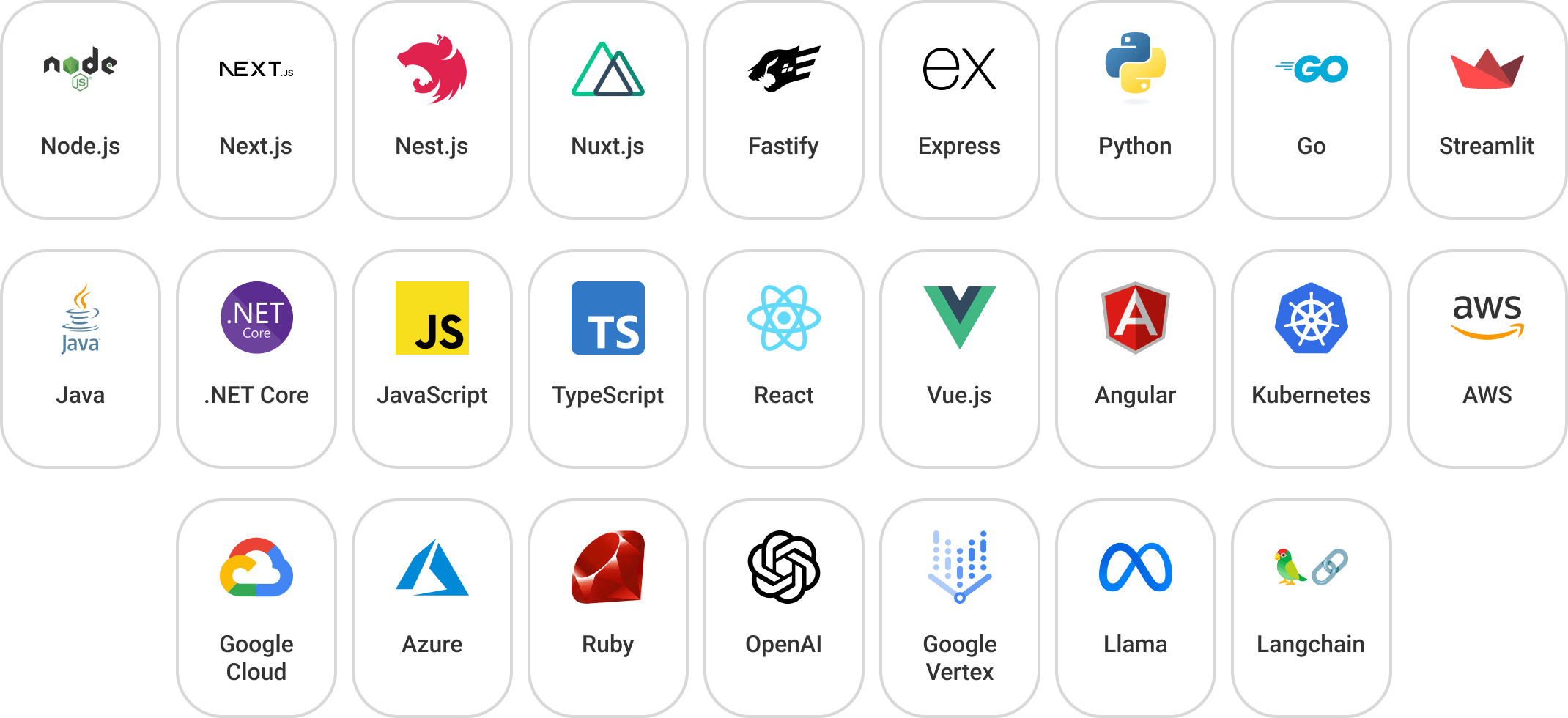Custom Software Development Services
Your business is unique. Your applications should be too. Our custom software development services deliver solutions that fit your distinct objectives and resolve your specific pain points. Partner with us to outperform your competitors and become the top choice in the market.

-
400+
successfully delivered projects across various industries
-
30%+
average order value increase with our OneClickUpsell app for Shopify
-
250+
dedicated professionals ready to tackle your custom software project
Full-Spectrum of Our Custom Software Development Expertise
-
Precision-Engineered Software Solutions
We don’t just build tools; we architect digital applications that empower your company to thrive. Our team of skilled engineers, well-versed in Node.js, Python, Java, and .NET Core, relies on the industry best practices to deliver high-performance, scalable solutions that optimize operations, elevate UX, and drive tangible results. With a meticulous focus on detail and a commitment to excellence, our software product development services transform your ideas into a finely-tuned app that fuels your competitive advantage.
-
User-Centric Mobile Solutions
Mobile applications are your brand ambassadors in the palm of your customer’s hands. That is why our mobile app development team helps you build user-friendly systems for both iOS and Android that exceed consumer expectations. As a result, you get native and cross-platform programs that boost engagement and seize the vast potential of mobile commerce. From employing technologies like augmented reality and geolocation to implementing robust security measures, our solutions are designed to foster lasting relationships with users and make your product stand out.
-
Strategic Software Advisory
Our custom software development consulting service goes beyond technical expertise. We analyze your distinctive business landscape, identify opportunities for growth, and craft a roadmap that aligns with your long-term objectives. Our data-driven approach to decision-making ensures that your investments bring significant returns. From selecting the right programming languages and backend technologies to optimizing solution creation processes, we assist you in building an ecosystem that is sustainable, efficient, and future-proof.
-
Immersive Web Experiences
Captivate your audience, not just with a website, but with an interactive journey tailored to your brand. We upgrade web application development into an art form, pairing stunning visuals with intuitive functionality. Whether you envision a responsive eCommerce platform, an engaging educational portal, or a functional workspace for your unit, our expert developers translate your ambitions into a high-performing web app. We guarantee it functions smoothly across all devices, providing a consistent experience for every user.
-

Intelligent Automation Solutions
We create AI-amplified custom software development solutions that facilitate your work in multiple scenarios. Imagine streamlining customer care with chatbots that answer questions and resolve issues 24/7. Personalize the shopping path with recommendation engines that suggest relevant products. Gain deeper insights from your data with predictive analytics that forecast trends and pinpoint white space in the market. Our systems powered by ML, NLP, deep learning, and LLMs seamlessly integrate with your existing infrastructure, eliminating bottlenecks and maximizing productivity.
-

Rapid Prototyping and Validation
With professional assistance, you can fast-track your development process and accelerate your time-to-market. At Master of Code Global, we utilize agile methodologies like Scrum and Kanban to design minimum viable products (MVPs) and proof-of-concept (PoC) solutions that capture the main functionalities of your envisioned software. Speedy prototyping allows you to test your concepts, gather valuable feedback, and validate demand before committing to a full-scale launch. By incorporating iterative refinements, you can also proactively mitigate risks and verify your product matches your client’s needs.
-
Rigorous Software Testing & QA
We don’t stop at custom software development; we meticulously investigate every line of code, function, and interaction to ensure flawless implementation. You can rely on our QA engineers, who employ a multi-pronged approach, utilizing automated testing frameworks and manual techniques to expose hidden bugs, vulnerabilities, and performance bottlenecks. Your solution won’t get just surface-level checks, we scrutinize the architecture and logic of your software to guarantee reliability, security, and frictionless functioning for your customers.
-

Flexible Software-as-a-Service
Our team of expert architects, developers, and DevOps engineers adopt technologies like Node.js, Python, and cloud platforms such as AWS and Azure to create scalable, secure, and cost-effective SaaS applications that facilitate the achievement of your company’s predefined milestones. From subscription management tools to data analytics platforms, we deliver end-to-end SaaS development, integration, migration, and support services to help you achieve your digital transformation goals.
-
Seamless API Integration
Need to streamline workflows, automate operations, or merge with third-party providers like Stripe, Google Maps, or USPS? Our API development services are your ideal choice. We incorporate resilient, reliable, and well-documented Application Programming Interfaces, such as RESTful or custom bot ones, that allow your software to communicate with other systems without disruptions. By leveraging APIs, you can unlock new features, improve data exchange, and enable a more connected and optimized network.
How Custom Software Solutions Empower Industry Leaders
Telecom
Insurance
Healthcare
Retail & eCommerce
Banking & Finance
Automotive
Education
Travel & Hospitality
Airports and Airline
Seamless communication is the backbone of modern business. We enable this with custom software development, from streamlined billing and provisioning systems to enhanced customer self-service portals.
In this sector, data is key. Our team helps firms capitalize on their massive datasets with various applications that automate underwriting processes, simplify claim management, and speed up risk assessment.
Medical providers face increasingly complex challenges in delivering quality care. We can help address these bottlenecks head-on, improving patient outcomes and standardizing operations through painless data sharing and optimized workflows.
Our software solutions allow retailers to use acquired insights for targeted marketing and coordinating omnichannel touchpoints. We also design visually appealing and user-friendly eCommerce platforms that captivate customers and drive sales.
From loan origination algorithms to mobile banking apps, our tailored programs empower financial institutions to thrive in the digital age. They become capable of automating transactions, simplifying loan processing, and providing personalized client assistance with greater ease.
In today’s fast-paced auto industry, our custom software development offers the agility and flexibility demanded. We assist with optimizing inventory management, streamlining service scheduling, and enhancing supply chain visibility for car agencies.
We create virtual learning environments that foster interactive training sessions, engaging educational apps that gamify knowledge acquisition, and tools that cut down on administrative tasks, allowing educators to focus on what matters most – student success.
From optimizing inventory to refining pricing strategies, we help you deliver unforgettable services that turn guests into loyal advocates. Expedite bookings with intuitive platforms, reward loyalty with personalized programs, and enhance guest journeys with mobile apps ensuring convenience in every detail.
Baggage handling instruments, flight scheduling software, and passenger DIY portals – our solutions optimize all processes, boosting efficiency, elevating travelers’ experiences, and keeping airports running smoothly.
Who We Help: Customized Solutions for Your Unique Business
-
Startup Apps
Being a seasoned technical partner and IT service provider, we understand the unique challenges faced by startups. We offer a custom software development strategy that is adjusted to your needs, empowering you to validate ideas, gain traction, and scale efficiently. We produce agile, cloud-based MVPs that adapt to your evolving requirements, ensuring you stay ahead in a competitive landscape.
- On-demand delivery applications
- Minimum viable products for market validation
- Interactive educational platforms
- AI-powered chatbots for customer support
- Inventory management systems for eCommerce
-
Mid-Size Business Software
Middle-tier companies need applications that grow with them. Our customized software solutions are designed to streamline operations, optimize processes, and enhance consumer experiences, driving revenue growth and operational efficiency. With our expertise in various technologies, we are capable of creating handcrafted systems that naturally connect with your existing setup.
- Custom CRMs for sales and marketing
- Cloud-based project administration systems
- Data analytics dashboards for decision-making
- Mobile apps for customer loyalty programs
- LLM-powered digital assistants
-
Enterprise-Level Solutions
As a trusted custom software development company in the USA, we cooperate with industry leaders to build enterprise-grade applications that solve complex problems and drive business transformation and further expansion. Our proficiency in microservices architecture, cloud-native engineering, and advanced security protocols ensures your software operates flawlessly and reliably, even in the most demanding environments.
- Enterprise resource planning (ERP) systems
- Supply chain management platforms
- Healthcare information systems (HIS)
- Financial risk management softwares
- Generative AI-powered knowledge bases
Results in Their Words: Client Feedback on Our Solutions
Unlock the Benefits of Engineering Excellence in Custom Software Development
-
Client-Focused Mindset
Our team is a powerhouse of talent, each member carefully selected for their outstanding skills and proven experience. Our developers craft efficient code; PMs ensure smooth dialogue and on-time fulfillment; and the designers create intuitive interfaces that delight users. Together, we form a coordinated unit to convert your ideas into high-performance software.
-
Results-Driven Expertise
With a deep understanding of complex systems and emerging technologies, we ensure your custom software development project is in capable hands. From conceptual design to hassle-free deployment, our team is devoted to crafting innovative, scalable programs that propel your business forward.
-
On-Time, On-Budget, On-Point
We focus on timely launch without sacrificing quality. Our custom software development company is committed to establishing realistic timelines, backed by a successful track record of delivering exceptional products on schedule and within budget. Our rigorous testing and QA processes guarantee your customized software meets the highest industry benchmarks.
-
Open Dialogue, Real Results
Open communication is the cornerstone of a productive partnership. We prioritize honest and ongoing interactions throughout the project lifecycle, providing regular progress updates and detailed reports. Our professional managers make certain you’re consistently informed and involved, fostering a seamless and collaborative journey.
-
ISO-Certified Security
Your data’s safety is non-negotiable. As an ISO-certified vendor, we adhere to stringent standards for PII protection and privacy. Our advanced security measures safeguard your sensitive information, ensuring your software is built on a foundation of trust. We also continuously monitor and update our protocols to stay ahead of arising threats
-
Flexible Collaboration Options
We recognize that each project is unique. That’s why we offer versatile cooperation approaches depending on your exact goals. Whether you seek to augment your existing team with specialized skill sets, require a dedicated development team, or prefer full outsourcing, we have the resources to adapt to your preferred model.
Meet Our Technology Stack

Transparent, Flexible, and Results-Driven Development Journey
Our team of expert custom software developers believes in creating more than just software; we build lasting partnerships. Our collaborative approach ensures you're not simply a client, but a valued partner throughout the entire project lifecycle and beyond.
-
Step 1
Discovery & Ideation
We thoroughly analyze your business goals, target audience, and challenges to create a strategic roadmap for achieving your desired software outcomes.
-
Step 2
Design & Prototyping
The next stage is generating interactive prototypes, incorporating wireframes and mockups to test user experience and refine your tailored solution.
-
Step 3
Development & Implementation
This phase involves agile engineering sprints with progress updates and demos, rigorous code reviews, and integration with existing systems.
-
Step 4
Quality Assurance & Testing
Validation across devices and platforms, including user acceptance testing, assures your app's peak functionality and security.
-
Step 5
Deployment & Launch
We deploy your software seamlessly, providing comprehensive user training and ongoing support to ensure optimal performance and long-term success.

















 Beauty & Cosmetics
Beauty & Cosmetics New York City, New York
New York City, New York 5,001-10,000 Employees
5,001-10,000 Employees Online Review
Online Review
 Verified
Verified
